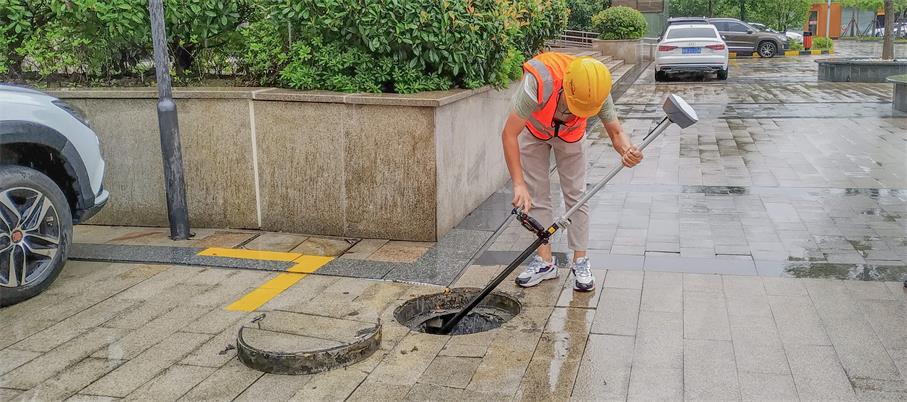RTK Tilt Measurement, Oscar's Ingenuity

The surveyors who measured the field knew that in order to accurately measure the ground point using the RTK receiver, the bubble on the ranging pole must be kept centered.
Nowadays, the measurement scenes have become diversified. There is no satellite signal measurement at the bridge hole edge; we cannot keep the ranging pole vertical to the ground measuring at the eaves corner, and we cannot keep the receiver vertical measuring under the urban manhole cover. These scenarios urgently require a receiver that can measure while being tilted. If we measure with the ranging pole in an oblique position, that is, from point to measure, the measurement will be completely free of leveling. It will not only go to points that conventional RTK cannot measure, but also improve the measurement accuracy in harsh environments and greatly improve the efficiency of surveying personnel.
The concept of tilt measuring RTK receivers has long been proposed by competitors. Facing the broad market and the customers, we can truly achieve calibration-free sensors without interference from the external environment and geo-magnetic interference, and maintain accuracy consistent with conventional RTK products recognized by customers that need to speak with real technology.
The latest generation of RTK tilt measurement technology adopts inertial measurement unit (IMU), along with combined inertial navigation algorithm, to provide high-frequency tilt compensation in real time and accurately calculate the coordinates of the survey point. The IMU module includes three single-axis accelerometers and three single-axis gyroscopes. The accelerometer detects the acceleration signals of the object in the carrier coordinate system independently of the three axes. The gyroscope detects the angular velocity signal of the carrier relative to the navigation coordinate system. Therefore, the receiver obtains the angular velocity and acceleration in three-dimensional space. The continuously measured acceleration and heading angle are used as tilt compensation, and the inertial navigation algorithm is integrated to calculate the position of the object in real time.
With the continuous competition among RTK tilt measurement receivers in the market, the technology continues to scale one peak after another, and is maturing. We have come indeed far from the previous generation tilt technology.
RTK tilt compensation technology is theoretically based on the inertial sensor RTK ranging pole tilt correction. The conventional tilt design generally uses an accelerometer and an electronic compass for tilt measurement. The principle is to use a magnetic field to calculate the yaw angle of the instrument and then the coordinates of the ground measurement point. This solution is theoretically feasible, but the tilt angle cannot be too large. The stability and accuracy of the tilt measurement are limited by the installation errors of the accelerometer and magnetometer in the electronic compass, and the errors of the electromagnetic interference environment on the magnetometer itself. It is difficult to achieve very high accuracy positioning with the conventional tilt measurement. We have summarized the three tilt compensation methods commonly used in the market as follows.
RTK tilt measurement technology | RTK Resection program | Accelerometer + Magnetometer | Accelerometer + Gyroscope |
Principle | Traditional resection positioning technology. | Provides accurate carrier attitude angle with accelerometer and calibrated magnetometer. | Calculates and maintains attitude angle using accelerometer and gyroscope, and maintains attitude angle based on GNSS speed, position and heading information |
Technical assessment | Model is mature and reliable, easy to implement, low cost, and process is complicated. | Easy to implement, the magnetometer is susceptible to interference and requires frequent calibration. | High accuracy and reliability, difficult to implement and high cost. |
Key Technology | - | Get high precision attitude angle of IMU, including tilt and heading. | |
| Pros and cons | - | 1. Need calibration 2. Low reliability | 1. No interference, no calibration required. 2. Accurate standards, high reliability. 3. High efficiency. |
It can be seen that the key to tilt measurement is the way to ensure accuracy.
The Tersus tilt receiver Oscar Ultimate adopts the latest generation of tilt compensation technology. The Built-in high-precision IMU inertial navigation module integrates inertial navigation and satellite combined navigation algorithm, make it truly immune to any external environment and objects.
Compared to the conventional tilt GNSS measurement, no calibration is needed for our Oscar Ultimate. The moment it is taken out from the instrument case, it is ready for accurate measurement and ready to use. Compared to the conventional tilt GNSS measurement, Oscar Ultimate is immune to electromagnetic interference and can be used anywhere. The measurement is started at power on, and is carried on the go. GPS measurement has since been freed from the constraints of leveling bubbles. The measurement efficiency has been improved by at least 20%, and measurement accuracy is more guaranteed.
Exclusive tilt fusion algorithm is the guarantee of tilt RTK measurement. Oscar Ultimate version is awaiting for your review!
About Tersus GNSS Inc.
Tersus is a leading GNSS RTK solution provider. Our engineers have been pioneers in the design of GNSS products to support high-precision positioning applications.
Our products include GNSS RTK & PPK OEM boards and receivers, as well as integrated solutions such as the David GNSS Receiver, Oscar GNSS Receiver, MatrixRTK, and GNSS-aided Inertial Navigation System.
Designed for easy and rapid integration, our GNSS solutions offer centimeter-level positioning accuracy and flexible interfaces for a variety of applications including: unmanned aerial vehicle (UAVs), surveying, mapping, construction engineering, and precision agriculture.
Sales inquiry: sales@tersus-gnss.com
Technical support: support@tersus-gnss.com
